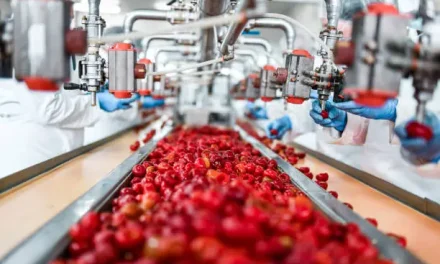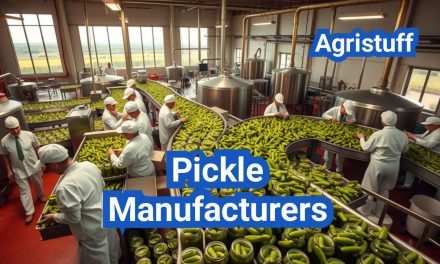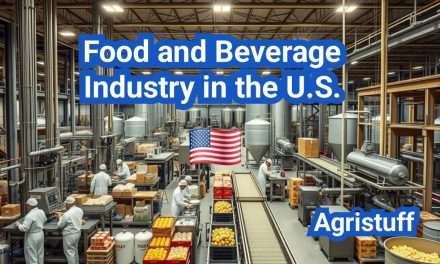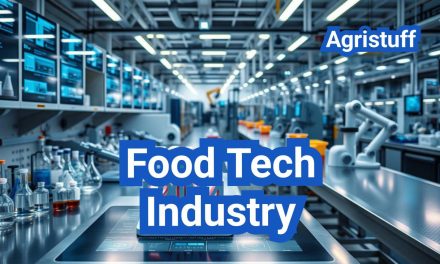The field of food process engineering is crucial in the development and manufacturing of safe and high-quality food products. It involves the application of engineering principles to improve the efficiency and effectiveness of food processing operations.
Western Engineering’s Master of Engineering (MEng) in Food Processing program provides students with the theoretical and practical skills needed to meet the demands of the food industry. This includes understanding thermal processing, HTST pasteurization design, and clean-in-place (CIP) cycle design.
Key Takeaways
- Understanding the principles of food process engineering
- Applying calculations to real-world food processing scenarios
- Examining real plant examples of food processing operations
- Learning about thermal processing and HTST pasteurization design
- Gaining insights into clean-in-place (CIP) cycle design
The Science of Food Process Engineering
Food process engineering is a multidisciplinary field that combines principles from engineering and food science to develop efficient food processing technologies. This field is crucial in ensuring the production of safe, high-quality food products that meet consumer demands.
Definition and Scope of Food Process Engineering
Food process engineering encompasses the application of engineering principles to food processing operations, including production, processing, packaging, and distribution. It involves understanding the complex interactions between food materials, processing conditions, and equipment design to optimize food processing systems.
The scope of food process engineering is broad, covering various aspects such as thermal processing, fluid dynamics, and membrane filtration. It requires a deep understanding of both the engineering aspects and the characteristics of food products.
Integration of Engineering Principles in Food Production
The integration of engineering principles in food production has led to significant advancements in food processing technologies. Process engineers play a vital role in designing and optimizing food processing systems, ensuring they are efficient, safe, and compliant with regulatory standards.
Engineering principles such as heat transfer, fluid mechanics, and mass transfer are applied to develop innovative food processing techniques. For instance, the use of high-temperature short-time (HTST) pasteurization has become a standard practice in the dairy industry, ensuring the safety and quality of milk products.
Key Challenges in Modern Food Processing
Despite the advancements, the food processing industry faces several challenges, including ensuring food safety, reducing energy consumption, and minimizing environmental impact. Food manufacturing engineers must continually adapt to changing consumer preferences, regulatory requirements, and technological advancements.
One of the key challenges is the development of sustainable food processing technologies that reduce waste and energy consumption while maintaining product quality. This requires innovative solutions and the application of cutting-edge technologies in food process engineering.
Thermal Processing Fundamentals and Applications

Understanding thermal processing fundamentals is essential for food engineers to design and optimize food processing systems. Thermal processing is a critical aspect of food processing that ensures the safety and quality of food products.
Heat Transfer Mechanisms in Food Systems
Heat transfer is a fundamental principle in thermal processing. There are three primary mechanisms of heat transfer: conduction, convection, and radiation. In food systems, conduction and convection are the most relevant. Conduction occurs through direct contact between particles or objects, while convection involves the movement of fluids to transfer heat.
Conduction is significant in solid foods, where heat is transferred from the surface to the interior. Convection is crucial in liquid foods, where the movement of the liquid facilitates heat transfer. Understanding these mechanisms is vital for designing effective thermal processing systems.
Calculating Thermal Process Values (F₀, P₀, C₀)
Thermal process values, such as F₀, P₀, and C₀, are critical in ensuring that food products are processed to achieve the desired level of sterility or pasteurization. F₀ represents the time required at a reference temperature (usually 121.1°C) to achieve a specific log reduction in microbial spores. P₀ and C₀ are related to pasteurization and cooking processes, respectively.
Calculating these values involves understanding the thermal resistance of the target microorganisms, the heat transfer characteristics of the food, and the processing conditions. Accurate calculations are essential for ensuring product safety and quality.
| Parameter | Description | Unit |
|---|---|---|
| F₀ | Time for log reduction at 121.1°C | minutes |
| P₀ | Pasteurization time at reference temperature | minutes |
| C₀ | Cooking time at reference temperature | minutes |
Commercial Sterilization vs. Pasteurization
Commercial sterilization and pasteurization are two distinct thermal processes used in food processing. Commercial sterilization aims to achieve a high level of microbial reduction, typically targeting Clostridium botulinum spores, to ensure the product is shelf-stable. Pasteurization, on the other hand, involves a milder heat treatment aimed at reducing the microbial load to a safe level without necessarily achieving sterility.
The choice between commercial sterilization and pasteurization depends on the product characteristics, desired shelf life, and storage conditions. Understanding the differences between these processes is crucial for selecting the appropriate thermal processing method for a specific food product.
Designing HTST Pasteurization Systems
Designing an efficient HTST pasteurization system involves understanding its key components and their configurations. HTST pasteurization is a critical process in the dairy industry, ensuring the safety and quality of milk and other liquid products.
HTST System Components and Configuration
An HTST pasteurization system consists of several key components, including a balance tank, a centrifugal pump, a regenerative section, a heating section, a holding tube, and a cooling section. The configuration of these components is crucial for achieving the desired pasteurization effect.
The regenerative section, for instance, plays a vital role in energy efficiency by preheating the incoming product with the heat from the pasteurized product. The heating section then brings the product to the required pasteurization temperature.
Calculating Holding Tube Length and Diameter
The holding tube is a critical component where the product is held at the pasteurization temperature for a specific period. Calculating the correct length and diameter of the holding tube is essential to ensure that the product is adequately pasteurized.
The length and diameter of the holding tube are determined based on the flow rate of the product, the pasteurization temperature, and the required holding time. Accurate calculations are necessary to prevent under-pasteurization or over-pasteurization.
Flow Control and Diversion Systems
Flow control systems are used to regulate the flow rate of the product through the HTST system, ensuring that it remains within the designed parameters. Diversion systems, on the other hand, are critical for preventing unpasteurized or under-pasteurized product from reaching the packaging line.
A flow diversion valve is typically used to divert the flow back to the balance tank if the product has not reached the required pasteurization temperature or if there is a fault in the system. This ensures that only properly pasteurized product is packaged and distributed.
Low-Acid Canned Food (LACF) Process Validation

The production of low-acid canned foods requires rigorous process validation to comply with FDA regulations and ensure product safety. This process is critical in preventing foodborne illnesses, particularly those caused by Clostridium botulinum.
FDA Regulations for LACF Products
The FDA has established strict guidelines for the production of LACF products. These regulations mandate that manufacturers implement a validated process to ensure that their products are safe for consumption. Key aspects of these regulations include:
- Registration of facilities that produce LACF products
- Submission of process filings (Form 2541) for review
- Implementation of a scheduled process that ensures the destruction of Clostridium botulinum spores
- Regular monitoring and record-keeping
Heat Penetration Studies and Protocol Development
Heat penetration studies are a crucial component of LACF process validation. These studies involve measuring the temperature at the coldest point of the product during processing to ensure that it reaches a sufficient temperature to kill harmful bacteria. The data collected from these studies are used to develop a protocol that outlines the specific processing conditions required to achieve commercial sterility.
The protocol should include details such as:
- Process temperature and time
- Container type and size
- Product formulation
- Any critical control points identified during the heat penetration study
Process Deviation Evaluation
Despite the best efforts of manufacturers, process deviations can occur. It is essential to have a plan in place to evaluate and respond to these deviations. This includes identifying the cause of the deviation, assessing its impact on product safety, and implementing corrective actions as necessary.
A robust process deviation evaluation plan should include:
- Procedures for identifying and reporting deviations
- Methods for assessing the impact of deviations on product safety
- Corrective actions to be taken in response to deviations
- Training for personnel on deviation handling and reporting
Clean-in-Place (CIP) System Engineering
Clean-in-Place (CIP) system engineering has become an essential aspect of modern food processing, focusing on efficient cleaning without system disassembly. The importance of CIP systems lies in their ability to maintain hygiene standards, reduce downtime, and increase overall productivity in food processing plants.
CIP Circuit Design and Component Selection
The design of a CIP system involves several critical components, including pumps, valves, and piping. Efficient circuit design ensures that cleaning solutions reach all parts of the processing equipment. The selection of components should be based on their compatibility with cleaning agents and their ability to withstand the CIP process.
When designing a CIP circuit, it’s essential to consider factors such as flow rate, pressure, and temperature. Proper flow rate ensures that all surfaces are adequately cleaned, while sufficient pressure helps in removing stubborn residues.
Calculating Cleaning Solution Concentrations
Determining the correct concentration of cleaning solutions is vital for effective cleaning. The concentration depends on the type of soil, the surface material, and the specific cleaning requirements of the equipment. Cleaning solution concentrations that are too low may not effectively remove contaminants, while concentrations that are too high can be wasteful and potentially damaging to equipment.
To calculate the optimal cleaning solution concentration, one must consider the volume of the CIP system, the type of cleaning agent, and the desired level of cleanliness. Accurate concentration calculations help in achieving the required level of cleanliness while minimizing costs and environmental impact.
Optimizing CIP Parameters for Different Food Applications
Different food processing applications require optimized CIP parameters to ensure effective cleaning. Factors such as temperature, cleaning time, and flow rate need to be adjusted based on the specific requirements of the application. For instance, dairy processing equipment may require different CIP parameters compared to equipment used in beverage processing.
Optimizing CIP parameters involves understanding the specific cleaning challenges of each application and adjusting the CIP system accordingly. This may involve conducting trials to determine the most effective cleaning protocols.
Fluid Dynamics in Food Pipelines

The design of efficient food pipelines relies heavily on understanding fluid dynamics. This knowledge is crucial for ensuring the safe and efficient transportation of food products through processing facilities.
Applying the Darcy–Weisbach Equation
The Darcy–Weisbach equation is a fundamental tool in calculating pressure drop in food pipelines. It is given by the formula: ΔP = f \* (L/D) \* (ρ \* v^2 / 2), where ΔP is the pressure drop, f is the Darcy friction factor, L is the length of the pipe, D is the diameter of the pipe, ρ is the fluid density, and v is the average velocity of the fluid.
To apply this equation effectively, it’s essential to determine the Darcy friction factor, which depends on the Reynolds number and the roughness of the pipe.
Calculating Reynolds Number for Food Products
The Reynolds number is a dimensionless quantity used to predict flow patterns in different fluid flow situations. It is calculated using the formula: Re = ρ \* v \* D / μ, where Re is the Reynolds number, ρ is the fluid density, v is the average velocity, D is the characteristic linear dimension (pipe diameter), and μ is the dynamic viscosity of the fluid.
For Newtonian fluids, this calculation is straightforward. However, many food products exhibit non-Newtonian behavior, requiring more complex rheological models.
Pressure Drop Calculations for Non-Newtonian Fluids
Non-Newtonian fluids, such as ketchup or yogurt, do not have a linear relationship between shear stress and shear rate. The pressure drop for these fluids can be calculated using modified versions of the Darcy–Weisbach equation that account for their rheological properties.
The following table summarizes key differences in calculating pressure drop for Newtonian and non-Newtonian fluids:
| Fluid Type | Reynolds Number Calculation | Pressure Drop Calculation |
|---|---|---|
| Newtonian | Re = ρ \* v \* D / μ | ΔP = f \* (L/D) \* (ρ \* v^2 / 2) |
| Non-Newtonian | Modified Re using apparent viscosity | ΔP using rheological models (e.g., Power Law, Herschel-Bulkley) |
Understanding these principles is crucial for designing efficient food processing systems and ensuring the quality of the final product.
Heat Exchanger Performance and Maintenance

Heat exchangers play a crucial role in food processing, and their performance directly impacts the overall efficiency of the operation. Effective heat exchanger maintenance is crucial for preventing downtime, ensuring product quality, and optimizing energy consumption.
Heat Transfer Coefficient Calculations
The heat transfer coefficient is a critical parameter in heat exchanger design and operation. It determines the rate at which heat is transferred between the product and the heating or cooling medium. Calculating the heat transfer coefficient involves considering factors such as fluid properties, flow rates, and surface characteristics.
“Accurate heat transfer coefficient calculations are essential for optimizing heat exchanger performance and ensuring the quality of the final product,” as emphasized by industry experts. The overall heat transfer coefficient (U) is calculated using the formula: 1/U = 1/h1 + 1/h2 + Rf, where h1 and h2 are the individual heat transfer coefficients, and Rf is the fouling resistance.
Plate Heat Exchanger Fouling Mechanisms and Monitoring
Fouling is a significant challenge in plate heat exchangers, leading to reduced heat transfer efficiency, increased pressure drop, and potential product contamination. Common fouling mechanisms include particulate fouling, crystallization fouling, and biofouling. Monitoring fouling involves tracking parameters such as pressure drop, heat transfer coefficient, and visual inspections during maintenance shutdowns.
- Particulate fouling: accumulation of particles on the heat transfer surface
- Crystallization fouling: precipitation of dissolved substances
- Biofouling: growth of microorganisms on the heat transfer surface
Cleaning Regimen Development
Developing an effective cleaning regimen is crucial for maintaining heat exchanger performance. The cleaning process should be tailored to the specific fouling mechanisms and the type of heat exchanger. Key factors to consider include cleaning agent selection, temperature, flow rate, and contact time. Regular cleaning and maintenance can significantly extend the lifespan of the heat exchanger and ensure optimal performance.
As noted by a leading manufacturer, “A well-designed cleaning regimen can reduce downtime, improve product quality, and lower operational costs.” The development of a cleaning regimen should be based on a thorough understanding of the fouling mechanisms and the heat exchanger design.
Membrane Filtration in Dairy Processing

With its ability to selectively separate components, membrane filtration plays a vital role in modern dairy processing. This technology has become indispensable for producing high-quality dairy products while maintaining process efficiency.
Membrane Selection for Different Dairy Applications
The selection of appropriate membranes is critical for the success of dairy processing operations. Different dairy applications require membranes with specific characteristics, such as pore size, material, and resistance to fouling.
- Microfiltration: Used for removing bacteria and fat globules from milk.
- Ultrafiltration: Employed for concentrating proteins and other large molecules.
- Nanofiltration: Utilized for partial demineralization and selective removal of ions.
- Reverse Osmosis: Applied for concentrating milk and whey by removing water.
Flux and Rejection Rate Calculations
Understanding and optimizing flux and rejection rates are crucial for efficient membrane filtration. Flux refers to the rate of permeate flow through the membrane, while rejection rate indicates the membrane’s ability to retain specific components.
To calculate flux, the following formula is used:
J = V / (A × t)
Where J is the flux, V is the volume of permeate, A is the membrane area, and t is the time.
Concentration Factor Determination
The concentration factor is a key parameter in membrane filtration processes, representing the ratio of the initial volume to the final volume of the retentate. It is crucial for determining the efficiency of the concentration process.
| Process | Concentration Factor | Typical Application |
|---|---|---|
| Ultrafiltration | 5-20 | Protein concentration |
| Nanofiltration | 2-5 | Partial demineralization |
| Reverse Osmosis | 3-6 | Concentration of milk and whey |
By carefully selecting membranes and optimizing process parameters like flux, rejection rate, and concentration factor, dairy processors can achieve high-quality products while maintaining efficient operations.
Individual Quick Freezing (IQF) System Design

Individual Quick Freezing (IQF) is a pivotal technology in the food industry, enabling the preservation of food quality through rapid freezing. IQF systems are designed to freeze products quickly, preventing the formation of large ice crystals that can damage the product’s texture and structure.
Freezing Time Calculations Using Plank’s Equation
Freezing time is a critical parameter in IQF system design. Plank’s equation is commonly used to calculate the freezing time of food products. The equation takes into account factors such as the product’s initial temperature, the freezing medium temperature, and the product’s dimensions.
The formula is given by: \(t = \frac{\rho L}{T_f – T_a} \left( \frac{D}{2h} + \frac{D^2}{8k} \right)\), where \(t\) is the freezing time, \(\rho\) is the density of the product, \(L\) is the latent heat of fusion, \(T_f\) is the freezing temperature, \(T_a\) is the temperature of the freezing medium, \(D\) is the diameter of the product, \(h\) is the heat transfer coefficient, and \(k\) is the thermal conductivity of the product.
Air Flow Rate and Temperature Requirements
The air flow rate and temperature are crucial factors in IQF system design. A higher air flow rate can enhance the heat transfer rate, thus reducing the freezing time. However, it also increases energy consumption. The optimal air flow rate is determined based on the product type and the desired freezing time.
Temperature control is also vital. The freezing temperature should be low enough to prevent microbial growth and enzymatic reactions. Typically, temperatures below -30°C are used for IQF.
Product Quality Optimization
Product quality optimization is a key objective in IQF system design. Factors such as freezing time, air flow rate, and temperature are optimized to preserve the product’s texture, flavor, and nutritional value. Proper design ensures that products are frozen uniformly, preventing issues such as clumping or uneven freezing.
In conclusion, IQF system design involves careful consideration of several factors, including freezing time calculations, air flow rate, and temperature requirements. By optimizing these parameters, food manufacturers can produce high-quality frozen products that meet consumer expectations.
Energy Efficiency Optimization in Food Plants

Energy efficiency optimization in food plants is a multifaceted approach that involves various strategies and technologies. As energy costs continue to rise, food processing facilities are under increasing pressure to reduce their energy consumption without compromising production quality or output.
Energy Audit Methodology for Food Processing Facilities
Conducting a comprehensive energy audit is the first step towards optimizing energy efficiency in food plants. This involves assessing current energy usage patterns, identifying areas of inefficiency, and pinpointing opportunities for improvement. An energy audit typically includes analyzing utility bills, inspecting equipment and facilities, and monitoring energy consumption in real-time.
Key components of an energy audit include:
- Reviewing historical energy consumption data
- Inspecting lighting, HVAC systems, and production equipment
- Identifying energy-saving opportunities
- Developing a comprehensive energy management plan
Heat Recovery System Design and ROI Calculations
Heat recovery systems are a crucial element in optimizing energy efficiency in food processing plants. These systems capture and reuse waste heat from various processes, reducing the need for additional heating and thereby lowering energy costs. The design of a heat recovery system involves assessing the plant’s heat sources and sinks, selecting appropriate heat exchangers, and integrating the system into existing processes.
Return on Investment (ROI) calculations for heat recovery systems are essential to justify the initial investment. These calculations consider factors such as energy savings, reduced maintenance costs, and potential increases in production efficiency.
| System Component | Energy Savings | ROI Period |
|---|---|---|
| Heat Exchanger | 20% | 3 years |
| Pump System | 15% | 5 years |
Refrigeration System Optimization
Refrigeration is a significant energy consumer in food processing plants, particularly in facilities handling perishable products. Optimizing refrigeration systems involves improving compressor efficiency, enhancing insulation, and implementing advanced control systems. Regular maintenance, such as cleaning condenser coils and checking for refrigerant leaks, is also crucial.
Strategies for optimizing refrigeration systems include:
- Upgrading to more efficient compressors and motors
- Implementing variable speed drives
- Improving system insulation and minimizing cold air losses
By implementing these strategies, food processing plants can significantly reduce their energy consumption, lower operational costs, and contribute to a more sustainable food production process.
Developing FSMA Preventive Controls Plans

Developing a preventive controls plan is crucial for food facilities under the FSMA regulations. The plan must be comprehensive, covering all aspects of food safety and including measures to minimize or prevent hazards.
Hazard Analysis Methodology
A thorough hazard analysis is the foundation of a preventive controls plan. This involves identifying potential biological, chemical, and physical hazards associated with the food product and processing environment.
The hazard analysis should consider the following:
- Raw materials and ingredients: Assess the risk of contamination from suppliers and the potential for hazards such as pathogens, allergens, or chemical contaminants.
- Processing steps: Evaluate the risk of contamination or growth of pathogens during processing, packaging, and storage.
- Environmental factors: Consider the potential for environmental contaminants, such as water or air-borne pathogens.
Critical Control Point Determination
Once potential hazards are identified, the next step is to determine the critical control points (CCPs) in the process. CCPs are points at which control can be applied to prevent or minimize a hazard.
The following steps should be taken to determine CCPs:
- Identify CCPs: Use a decision tree or other systematic approach to identify CCPs in the process.
- Establish critical limits: Define the critical limits for each CCP, such as temperature, pH, or moisture level.
- Monitor CCPs: Implement a monitoring system to ensure that CCPs are within the established critical limits.
Validation of Process Controls
Validation is a critical step in ensuring that the preventive controls plan is effective. This involves verifying that the controls in place are capable of preventing or minimizing hazards.
The following should be considered during validation:
- Scientific evidence: Use scientific evidence and data to support the effectiveness of the controls.
- Process validation: Validate the process by conducting experiments or tests to ensure that the controls are effective.
- Ongoing verification: Continuously verify that the controls remain effective over time.
By following these steps and developing a comprehensive preventive controls plan, food facilities can ensure compliance with FSMA regulations and minimize the risk of food safety hazards.
Real-World Case Studies in Food Process Engineering

Real-world case studies in food process engineering offer practical examples of how theoretical principles are applied to improve food production efficiency and safety. These studies provide valuable insights into the challenges faced by food manufacturers and the engineering solutions implemented to address them.
Dairy Plant Pasteurization System Optimization
A leading dairy plant faced challenges with its pasteurization system, including inconsistent temperature control and high energy consumption. By applying food process engineering principles, the plant optimized its pasteurization process, achieving a 20% reduction in energy costs and improving product safety.
- Implemented advanced temperature control systems for precise heating and cooling.
- Optimized pasteurization parameters to ensure compliance with regulatory standards.
- Conducted regular maintenance to prevent equipment fouling and ensure efficiency.
As noted by experts, “Optimizing pasteurization systems not only improves energy efficiency but also enhances product quality and safety” (
Journal of Food Engineering
).
Beverage Production Line Efficiency Improvement
A beverage manufacturer sought to improve the efficiency of its production line, which was experiencing bottlenecks and high waste rates. Through the application of food process engineering principles, the manufacturer was able to increase production capacity by 15% and reduce waste by 10%.
- Analyzed production line workflow to identify bottlenecks.
- Implemented lean manufacturing techniques to streamline processes.
- Upgraded equipment to improve filling and capping efficiency.
Meat Processing Facility HACCP Implementation
A meat processing facility implemented a Hazard Analysis and Critical Control Points (HACCP) plan to enhance food safety. The plan involved identifying potential hazards, establishing critical control points, and implementing monitoring and corrective actions.
The facility achieved full compliance with food safety regulations and reduced the risk of product contamination. Key steps included:
- Conducting a thorough hazard analysis.
- Establishing critical control points for temperature control and sanitation.
- Training staff on HACCP procedures and importance.
These case studies demonstrate the significant impact of food process engineering on improving food production processes, enhancing product safety, and reducing operational costs.
At The End of: Food Process Engineering
Food process engineering plays a vital role in ensuring the safety and quality of food products. This article has explored various aspects of this field, from thermal processing fundamentals to the design of Clean-in-Place (CIP) systems.
The importance of precise calculations and process validation cannot be overstated, as they directly impact the efficacy of food processing operations. By understanding principles such as heat transfer, fluid dynamics, and membrane filtration, food manufacturers can optimize their processes to produce high-quality products while minimizing energy consumption and environmental impact.
Effective food process engineering also involves adherence to regulatory requirements, such as those outlined in the FDA’s regulations for Low-Acid Canned Food (LACF) products and the Food Safety Modernization Act (FSMA) Preventive Controls Plans. By integrating these principles and regulations into their operations, food manufacturers can ensure compliance and maintain consumer trust.
In conclusion, food process engineering is a critical component of modern food production, enabling manufacturers to produce safe, high-quality products while optimizing efficiency and reducing environmental impact.
FAQ
What is food process engineering?
Food process engineering is the application of engineering principles to the production, processing, and packaging of food products. It involves the design, development, and optimization of food processing systems to ensure safe, efficient, and high-quality food production.
What are the key challenges in modern food processing?
Some of the key challenges in modern food processing include ensuring food safety, reducing energy consumption, minimizing waste, and improving product quality. Food process engineers must also stay up-to-date with changing regulations and consumer preferences.
What is thermal processing, and how is it used in food production?
Thermal processing involves the use of heat to preserve or cook food products. It is commonly used in the production of canned goods, pasteurized dairy products, and sterilized foods. Thermal processing can be achieved through various methods, including retorting, pasteurization, and sterilization.
How is HTST pasteurization designed?
HTST (High-Temperature Short-Time) pasteurization is designed by selecting the appropriate equipment, including heat exchangers and holding tubes, and configuring the system to achieve the required temperature and holding time. The design must also include flow control and diversion systems to ensure that the product is properly pasteurized.
What is the importance of process validation for LACF products?
Process validation is critical for Low-Acid Canned Food (LACF) products to ensure that they are safe for consumption. The FDA requires that LACF products be processed according to a validated process that ensures the destruction of Clostridium botulinum spores.
How is CIP system engineering used in food processing?
CIP (Clean-in-Place) system engineering is used to design and optimize cleaning systems for food processing equipment. The goal of CIP is to ensure that equipment is thoroughly cleaned and sanitized to prevent contamination and ensure food safety.
What is the Darcy–Weisbach equation, and how is it used in food pipelines?
The Darcy–Weisbach equation is a mathematical formula used to calculate the pressure drop in a pipe due to friction. In food pipelines, the equation is used to determine the pressure drop and flow rate of food products, which is essential for designing and optimizing food processing systems.
How is membrane filtration used in dairy processing?
Membrane filtration is used in dairy processing to separate and concentrate dairy products, such as milk and whey. The process involves the use of semipermeable membranes to remove impurities and concentrate the product.
What is IQF freezing, and how is it used in food processing?
IQF (Individual Quick Freezing) is a freezing process that involves rapidly freezing individual pieces of food, such as fruits and vegetables. The process helps to preserve the quality and texture of the product.
How can energy efficiency be optimized in food plants?
Energy efficiency can be optimized in food plants by conducting energy audits, implementing heat recovery systems, and optimizing refrigeration systems. Additionally, food process engineers can optimize equipment design and operation to reduce energy consumption.
What is FSMA, and how does it relate to food process engineering?
FSMA (Food Safety Modernization Act) is a regulation that requires food manufacturers to implement preventive controls to ensure food safety. Food process engineers play a critical role in developing and implementing FSMA-compliant systems.
What are some real-world applications of food process engineering?
Food process engineering has many real-world applications, including the optimization of pasteurization systems, improvement of production line efficiency, and implementation of HACCP (Hazard Analysis and Critical Control Points) systems.
Conclusion of: Food Process Engineering
What is food process engineering—and why it matters
Food process engineering is the discipline that blends engineering, physics, chemistry, and microbiology to convert agricultural raw materials into safe, high-quality foods at scale. In day-to-day operations across the United States, food process engineering drives decisions about heating and cooling profiles, line speeds, cleaning cycles, and packaging conditions while meeting regulatory and customer requirements. For plant managers, this field provides the toolkit to balance throughput, quality, and cost without compromising food safety or employee welfare. To anchor your understanding, professional communities and applied research in food process engineering offer frameworks and best practices that shorten the path from theory to production-ready implementation. Institute of Food Technologists – Food Engineering Division.
Where food process engineering fits in the U.S. food sector
The U.S. food and beverage sector is a vast network of processors, packers, cold-chain operators, and distributors; food process engineering sits at its core, translating market demand into consistent, compliant production. By applying food process engineering principles, plants lower energy and water intensity, reduce waste, and maintain tight specifications—from moisture content and Brix to pH and texture. Understanding industry structure and trends helps engineers benchmark KPIs and set realistic upgrade roadmaps, whether for a dairy, tomato paste plant, or frozen vegetable line. Sector overviews also guide capital planning by showing where food process engineering can yield the highest ROI through debottlenecking or modernization. USDA ERS – Food & Beverage Manufacturing.
Core building blocks: unit operations and transport phenomena
Food process engineering organizes manufacturing around unit operations such as heating, cooling, mixing, separation, size reduction, and packaging. Each operation is governed by transport phenomena—momentum, heat, and mass transfer—and, when relevant, reaction kinetics for enzyme control or microbial inactivation. In practice, food process engineering connects these fundamentals to plant realities like hygienic stainless-steel design, self-draining piping, instrumentation accuracy, and statistical process control so that yields, quality, and safety move in the right direction together. IFT – Food Engineering Topic Overview.
Regulatory framework: FSMA sets the baseline
In the U.S., food process engineering is inseparable from compliance with the Food Safety Modernization Act (FSMA). Engineers collaborate with QA to design hazard analyses, preventive controls, monitoring, corrective actions, and verification activities that align with FSMA’s rules for human food. The result is an integrated system where food process engineering decisions—such as thermal setpoints or sanitation cycles—are validated and documented to protect consumers and brands. Training, recordkeeping, and supply-chain controls are integral parts of this framework. FDA – FSMA Preventive Controls for Human Food.
Pasteurization minimums: how food process engineering protects milk quality
A classic example in food process engineering is HTST pasteurization of Grade “A” milk, typically designed around 72 °C (161 °F) for ≥15 s with validated holding tubes and flow-diversion valves. Food process engineering ensures legal safeguards, proper pressure differentials, and energy-saving regeneration sections in plate heat exchangers. Validation and routine checks are codified under the PMO, which guides equipment selection and control logic in U.S. dairies.
Low-acid canned foods (LACF): proof of safety by design
For shelf-stable foods, food process engineering must demonstrate safe processes for low-acid canned foods and acidified foods through thermal validation, container integrity, and regulatory filings. Concepts like F0, z-value, and worst-case “cold spot” dictate retort schedules and come-up times. Food process engineering translates these into documented, auditable parameters that keep risk within acceptable limits and satisfy federal oversight. FDA – LACF & Acidified Foods Guidance.
Hygienic design and CIP: the cleaning backbone
Sanitary design underpins every decision in food process engineering: avoid dead legs, maintain self-drainage, and enable effective clean-in-place (CIP) and sanitize-in-place (SIP). Engineers specify circulation velocities, turbulence, temperature, and chemistry matched to soils (protein, fat, minerals) and validate that cycles remove residues consistently. Good CIP design in food process engineering protects uptime, heat-transfer performance, and—most importantly—consumer safety. UF/IFAS – Cleaning & Sanitizing in Food Processing.
Material and energy balances: the universal language
Every project in food process engineering begins with material and energy balances. Consider drying 1,000 kg/h of diced vegetables from 88% to 10% moisture (wet basis): component balances determine product and evaporated water rates, which then convert to heater duty by summing sensible and latent loads. Food process engineering uses these balances to size utilities, select equipment, and benchmark performance before capital is committed. UMass – Moisture in Foods (definitions & formulas).
Heat transfer & holding time: getting the seconds right
In continuous systems, food process engineering computes holding time as holding-tube volume divided by volumetric flow (adjusted for non-ideal flow). Teams verify with tracer tests and pressure profiles, then use regenerative sections in plate heat exchangers to save energy. Control logic—such as flow diversion when temperature drops—translates food process engineering fundamentals into automated compliance. Cornell CALS – HTST Pasteurizer Workshop.
Retorts & F0: lethality by the numbers
Food process engineering quantifies microbial inactivation via F0, integrating time–temperature histories at an equivalent of 121.1 °C. By selecting an appropriate z-value and accounting for come-up and cooling, engineers create schedules that meet safety targets without overcooking. Proper documentation, deviation handling, and container integrity checks complete the validation package in food process engineering for shelf-stable lines. FDA – Thermal Processing Guidance.
Drying & mass transfer: managing the driving force
Drying success in food process engineering depends on the mass-transfer driving force (temperature and humidity), exposed surface area, airflow uniformity, and internal diffusion through the product matrix. Engineers convert wet-basis to dry-basis moisture, estimate drying curves, and anticipate falling-rate periods where internal diffusion controls time. Good dryer design in food process engineering preserves color, flavor, and solubility while hitting water activity targets. FAO – Grain Drying, Handling & Storage.
Fluid flow & pumping: Darcy–Weisbach in the plant
From milk pipelines to sauce transfer lines, food process engineering uses the Darcy–Weisbach equation to calculate head loss: hf = f (L/D) (v²/2g). Reynolds number determines flow regime, friction factors, and velocity targets that prevent sedimentation while maintaining CIP shear at the walls. Correct pump sizing in food process engineering avoids cavitation, protects seals, and keeps flows within validated holding-time assumptions. Santa Clara Univ. – Pipe Flow Energy Losses.
Mixing & scale-up: power, blend time, and rheology
Food slurries often exhibit non-Newtonian behavior; thus, food process engineering selects impellers and speeds based on dimensionless correlations (Re, Fr, Po) and apparent viscosity at process shear rates. Baffles, tank geometry, and impeller type (axial vs. radial) set blend time and power draw. Pilot data guide scale-up so full-size mixers deliver homogeneous products without over-shear. University of Michigan – Mixing Correlations.
Rheology in practice: why ketchup shear-thins
Many sauces, purees, and condiments are shear-thinning or have yield stress; food process engineering models these with power-law or Herschel–Bulkley equations to size pumps, holding tubes, and fillers. Matching shear conditions between lab and plant prevents surprises like under-holding or excessive pressure drop, ensuring that food process engineering models reflect real throughput. UMass – Rheology of Foods.
Heat exchangers & fouling: choosing the right surface
Plate heat exchangers deliver high heat-transfer coefficients for low-viscosity, particulate-free products; tubular or scraped-surface units suit viscous or particulate foods. Food process engineering mitigates fouling through velocity, surface pattern, and CIP cycle design, preserving performance between cleanings. Lifecycle cost analyses help justify upgrades that improve energy recovery and uptime in food process engineering projects. Alfa Laval – Plate Heat Exchangers (Technical Overview).
Membrane separations: gentle concentration and clarification
Microfiltration, ultrafiltration, nanofiltration, and reverse osmosis enable concentration and standardization with minimal heat damage. In dairy and beverages, food process engineering targets flux, transmembrane pressure, and fouling behavior while ensuring cleanability and microbiological control. Membrane selection and staging are optimized to balance yield, quality, and CIP cycle time in modern food process engineering lines.
Freezing time: from Plank to spiral freezers
Designing freezers requires models that account for geometry, thermal properties, surface heat transfer, and subcooling—not just latent heat. Food process engineering applies improved Plank-type methods to estimate freezing times and compressor loads, ensuring IQF tunnels and plate freezers achieve target core temperatures uniformly. This preserves texture and color while meeting HACCP limits in food process engineering operations. UMKC – Freezing Times of Regularly Shaped Foods.
Transportation & the cold chain: FSMA keeps it clean
Food safety doesn’t stop at the dock. The FSMA Sanitary Transportation rule sets responsibilities for shippers, carriers, and receivers regarding temperature control, vehicle design, cleaning, and recordkeeping. Food process engineering contributes to these specifications by defining setpoints, monitoring, and acceptance criteria that protect product integrity throughout distribution. FDA – Sanitary Transportation of Human & Animal Food.
Energy & water KPIs: targets every plant should track
Modern plants use food process engineering to reduce energy (steam, electricity, refrigeration) and water per pound of product. Typical projects include heat recovery, VFDs on pumps and fans, compressed-air optimization, and CIP water reuse—with dashboards to verify savings. Benchmarking against national programs helps food process engineering teams prioritize upgrades with measurable ROI. EPA ENERGY STAR – Industry (Resources & Tools).
Real plant example #1: dairy HTST line
A typical HTST system in food process engineering includes raw silo → balance tank → plate heat exchanger (regeneration) → booster pump → heater section → holding tube (≥15 s) → flow-diversion valve → cooler → homogenizer → pasteurized silo → filler. Food process engineering verifies holding-time volume, pressure differentials to prevent raw-to-pasteurized leakage, and regeneration efficiency, with validation and operator training built into the PMO framework. Cornell – HTST Pasteurizer Workshop.
Real plant example #2: tomato paste concentration
Tomato processors use multi-effect evaporators to reach 28–36° Brix while preserving color and flavor. Food process engineering optimizes residence time, thermal economy (using vapor from one effect to heat the next), and condensate reuse. Fouling management and vacuum level control are critical to maintain throughput and product quality in continuous concentration lines designed by food process engineering teams. UC Davis – Food Science Pilot Plant.
Real plant example #3: frozen vegetables (blanch → IQF)
A blanch-cool-dewater-IQF sequence relies on food process engineering to set enzyme inactivation targets in the blancher, manage belt loading and air velocity in the freezer, and confirm uniform core temperatures. Load calculations include sensible, latent, and subcooling components, while sampling plans verify HACCP and FSMA compliance. Food process engineering balances quality (texture, color) with capacity and energy cost. Virginia Tech – Freezing of Food.
Final thought
From dairies in Wisconsin to vegetable processors in the Pacific Northwest, food process engineering is the bridge between regulatory compliance, product quality, and competitive unit costs. The plants that excel treat food process engineering as a continuous-improvement engine—model, validate, monitor, and optimize—so every batch is safer, more consistent, and more sustainable than the last. IFT – Food Engineering Community.
Sources & References
- FDA – FSMA Preventive Controls for Human Food
- UF/IFAS – Cleaning & Sanitizing in Food Processing
- UMass – Moisture in Foods
- Cornell CALS – HTST Pasteurizer Workshop
- FAO – Grain Drying, Handling & Storage
- Alfa Laval – Plate Heat Exchangers
- University of Michigan – Mixing Correlations
- UMass – Rheology of Foods
- UMKC – Freezing Times of Regularly Shaped Foods
- FDA – Sanitary Transportation Rule
- USDA ERS – Food & Beverage Manufacturing
- EPA ENERGY STAR – Industry Resources
- Virginia Tech – Freezing of Food
- IFT – Food Engineering Division










